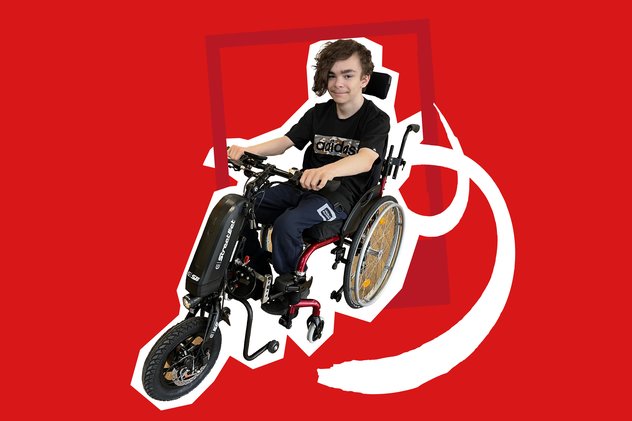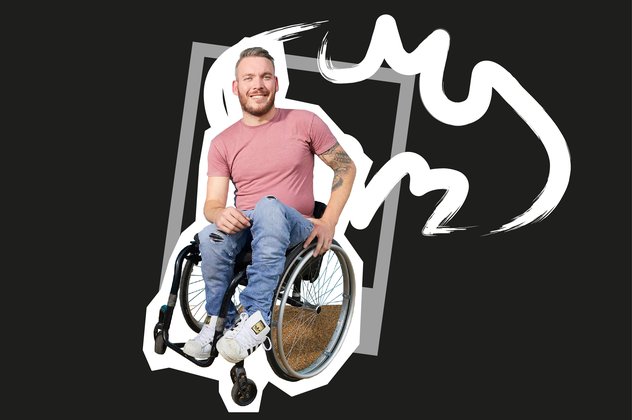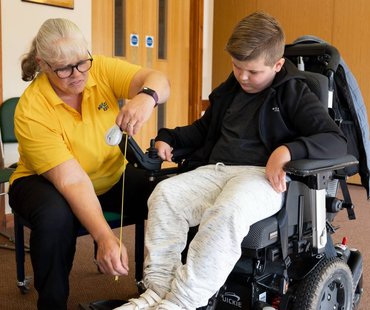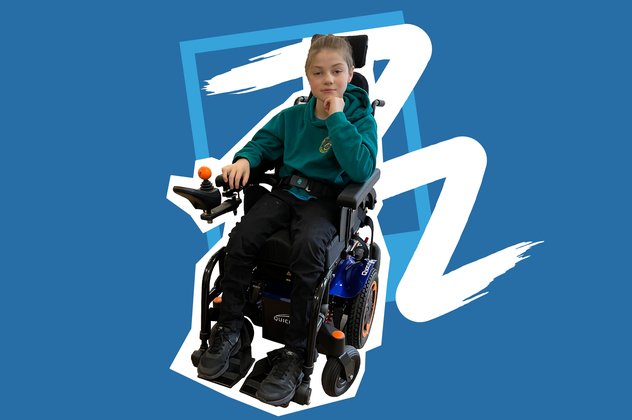Choosing your wheelchair's colour: Every shade tells a story
Celebrating wheelchairs and all the colours they now come in with three of Whizz Kidz's most experienced therapists
Of all the astonishing things about colour, the most amazing is that it doesn’t exist outside your head. Colour is a lie. Your brain creates it to help you interact with the world. Do you remember the viral dress that no one could agree on whether it was blue or white? That's because colour is a matter of perception. How else can you explain them getting away with calling paint colours names like Peach Fuzz, Elephant’s Breath or Disco Nap? What colours even are they? (Answers: “between pink and orange”, “mid-grey”, and “light acid-yellow”, apparently.)
Perception is everything when we think about the colour of wheelchairs, too. There’s a rainbow of difference between how wheelchair users see wheelchairs and how the general public pictures them.
For the young people and their families in our community, wheelchairs come in a bright spectrum of colours that match how they feel about their equipment. When they have a high-quality wheelchair personalised to meet their needs from Whizz Kidz, the fact they get to choose the colour is important. These are much-loved, personal pieces of equipment which you want to get in your favourite colour to match your football team, superhero, or flag.
However, for many in wider society, wheelchairs are still stigmatised. They are depressing medical devices you are “confined” to or “bound” by. Why would you want them even to have a colour?


International Wheelchair Day in colour
This is why we’re celebrating International Wheelchair Day (1st March) by sharing the shades that our wheelchairs come in. Follow us on social media as we ask, what colour is your wheelchair and what does it say about you? #ShareYourShade and tell us the story behind your wheelchair's colour.
It wasn't always like this. Wheelchairs used to be any colour as long as it was grey. But now there are more than even the Mantis shrimp, which has 16 vision cones in its eyes compared to our red, green and blue three, can imagine, including Frutti Orange, Sky Blue, Dark Chocolate Metallic, Iridescent Purple, Cappuccino, Flamingo Glitter, Black Opal, Desert Camouflage and many, many more. Do you still want grey? Look for Brilliant Silver or Platinum Metallic.


How do young people pick their colour?
We caught up with Whizz Kidz Senior Mobility Therapists Sarah Wallace (above), Alison Honour and Helen Braden to learn more about choosing wheelchair colours. They assess the needs of hundreds of young people every year and give them the opportunity to pick their colour as they fit them with the right wheelchair.
What are the main things that influence that important shade selection?
“Football and superheroes” are the unanimous most popular reasons for deciding on a colour. Spider-Man's blue and red signature suit looms large in many younger people’s thoughts, along with “specific racing cars, tractors and Transformers”, says Helen. She’s been a physiotherapist for 30 years, 12 at Whizz Kidz.
It can depend on “whether they want to stand out or do the opposite. Or what colour their friends have,” Alison says, who has been an occupational therapist for 35 years, two at Whizz Kidz.
“Or what colour clothes they like to wear”, adds Sarah, with a 39-year career as an occupational therapist, 26 at this charity.
“I’ve got one boy that wanted the same colours as the Jamaican flag,” she says. “So he had a green frame and a yellow backrest. And we didn’t know what we would do about the black bit, but because of the black cross on the back of the yellow chair, it brightens everything.”
“The other thing I had the other day was choosing a colour because of The Masked Singer. It's not a show that I watch. But yes, this was a mum who really, really didn't want orange. So I think the child's now having silver and blue or silver and red. She persuaded him that he didn't want orange because silver and red were the same as a character on The Masked Singer.”
#Share your shade
What colour is your wheelchair?
Manchester United Red.
What does it say about you?
It feels really cool to support our football team with something that I'll use in everyday life.
Blake

Do young people and families agree?
Do you get a clash of colour choices between parents and children?
“I think sometimes they want what the mum doesn't want,” says Alison. “I had a funny one last week, a little boy who was adamantly white and pink, and mum was trying everything to convince him about almost any colour apart from pink. She was talking about Spider-Man and everything, and he was so cute, but he kept coming back to pink. Everything that was suggested came back to pink.”
But as therapists, you have to stay neutral.
“I didn't agree or disagree,” says Alison.
“I find that really challenging,” says Helen.
“It’s a difficult one, isn't it? It is a difficult one. I think the child should have the last say,” says Sarah.
“He's only three, so I think there's a lot of scope that he would have changed his mind before he would have changed his chair,” Alison adds.
Pink can be a difficult colour because it’s still so embedded in society that it’s “for girls”. With wheelchairs lasting for four or five years, the colour choice will stick with the young wheelchair user as they grow up. As Sarah points out, wearing a pink t-shirt for a day differs from having a pink chair every day for five years.

…it's that awakening and realising that they have potential. Or they've tried something out, and they think, wow, I can do this...
Helen Braden, Senior Mobility Therapist
Do you grow out of some colours?
Do they see a significant change in colour choices with the transition from childhood to teenage? Not necessarily.“I've seen young people that have always had the same colour chair,” Helen says. “They dislike change. So the way they accept their new chair is that it looks the same as their old one. So I have one that always had green, and it had to be green.”
“Yeah, I have a young person that always has a red chair. And it has a name,” says Sarah. “And so when he had to change the chair, that was pretty tricky. So it became whatever-its-name-was-Senior or -Mark Two.”
Whichever colours young people choose for their chairs, the most important thing is that they get a choice.
“It allows them to express themselves,” says Helen.
“It’s like us choosing our glasses or something, isn’t it? It becomes part of you,” says Alison. “I think that anything that people can have a choice in that affects them, they should be able to have that choice, shouldn’t they?”
“Definitely,” adds Sarah. “And I think, going back to the pink scenario, if a teenage boy wanted pink, I wouldn't have a problem with that. Because that obviously is an expression of themselves.”

I often start off now by saying this isn't to decide whether we can help you, it’s to decide what the best piece of equipment is that we can give you...
Alison Honour, Senior Mobility Therapist
What to consider on colour in clinic
Choosing your wheelchair colour at Whizz Kidz is a fun part of your visit to our mobility clinics. The therapists have colour swatches, in both laminated plastic and a jangling keyring of metal discs, that are perfect for distracting younger visitors, to help you decide. While you can’t beat seeing a selection of shiny finishes in front of you, the manufacturers we work with, like Sunrise Medical, have sophisticated visualiser pages on their websites where you can customise your wheelchair’s look to your heart’s content.
It’s important to note, though, that while every young person gets to choose from a set range of colours, some non-standard options are not funded by the charity and must be paid for. With everything from sleek anodised aluminium finishes to flame effect paint jobs, there are so many elements of modern wheelchairs that can be customised; it’s more like buying a new luxury car. Sure, you could get carried away with the optional extras, but the core colours are classic for a reason. No one is missing out!
Customising your wheels
All three therapists are enthusiastic about the cheaper ways to pimp your wheelchair and make it “look great and a bit different,” says Sarah. One of the most effective are spoke wraps, long straws in multiple colours that are easy to fit and “cost almost nothing,” Alison adds. Or Helen suggests adding some stick-on LED light strips. (If you go down the customisation route, share your look with us on social media).
Our therapists and engineers see hundreds of shiny new wheelchairs a year. What colours would they pick?
Sarah: “Iridescent Navy is an amazing colour. It’s very dark navy but matte with a little shine. Not as flamboyant as glitter. But there's just something about it. A perfect teenage colour.”
Alison: “I think I'd go for teal. That is my favourite. I wear a lot of teal clothes, and I have a lot of teal in my house. I like it. “
Helen: “Silver and teal look lovely together…”
Not surprisingly, all our therapists get excited when a new wheelchair arrives in a young person’s chosen colours.
Helen says: “When Jonathan brings them off the van, or Mark brings them off the van [two of our Engineers], you always do feel excited and think, oh, yes, that does look good. And you know, sometimes they've chosen the frame and the accent colour, and you think, I'm not sure that's going to work. But it does.”
#Share your shade
What colour is your wheelchair?
Black
What does it say about you?
The main reason I have a black wheelchair is, when I was younger, I always wanted to be Batman.
Martin Dougan
Broadcaster

Seeing all your assessments and expertise come together must be a high point. But what’s the best thing about being a mobility therapist at Whizz Kidz?
Helen: “The smiles. The excitement. Being able to move independently, for the first time sometimes.”
Sarah: “I mean, parents often say, they didn't sleep, that the child didn't sleep well the previous night, because they were so excited.”
Alison: “Yeah, handing over equipment you know is going to make a difference to somebody's life.”
“And especially when you hear afterwards about what they've been able to do, or even when you hand over the chair and they tell you what they're going to do that they couldn't do before. Places they can go that they couldn't have gone otherwise or places they can go by themselves that they couldn't have gone by themselves.”
“You know, I was thinking, I love the point of handover, but sometimes I actually really enjoy the assessment part,” says Helen. “When you see a child come in who's, you know, maybe a bit shy or unsure, and you suddenly start to involve them in this assessment and start to get them to make decisions, you see them come out of their shell or grow in confidence.”
“And okay, they haven't got their equipment yet, but it's that awakening and realising that they have potential or they've tried something out, and they think, wow, I can do this. And then, at the end of that, the family go, so are they allowed a chair? Of course they are!”

Parents often say that the child didn't sleep well the previous night, because they were so excited...
Sarah Wallace, Senior Mobility Therapist
After sometimes trying for years to access the support they need from local services, many parents and carers come to Whizz Kidz worried that we won’t be able to help. Our therapists have nothing but reassurance to offer.
Alison says: “I quite often start off now by saying this isn't to decide whether we can help you, it’s to decide what the best piece of equipment is that we can give you. Because a lot of people feel like they've got to prove during the assessment that they need something.”
Sarah: “I always say that in the phone assessment, you know, there's no right and wrong answers. It's about you painting a picture.”
Alison: “Some people don't like working with families because it's not just one person, and you're not just trying to meet one person's needs; you're looking at someone as part of a family, which is very much what we do. And I love doing that, but some people don't like it because it's complex.”
How they communicate in clinic
Anyone attending Whizz Kidz’s clinics will see firsthand how our therapists and engineers constantly adjust how they speak to young people with different needs and abilities throughout the day, almost as much as they adjust their mobility equipment. Do you train for such a highly tailored approach to communicating with young people and families?
Alison says, “I think it comes with experience and time. I don't know if you can be trained to do it, but I think it's a vitally important part of the job that you can just switch how you communicate with someone depending on their age and ability. But it's much more than that as well, isn't it? It's also on things like class and education. And we just do it automatically, but I think it is really, really important.”
#Share your shade
What colour is your wheelchair?
Blue and orange.
What does it say about you?
Blue and orange are on the opposite sides of the colour wheel. That's very different. And I like to be different.
Samuel

“Going back to colours again,” says Sarah. If you had a younger, say, primary school-age child who had severe learning difficulties and maybe some autistic traits as well, you'd probably get the parent to offer them three or four colours. Let the parent choose the ones that they know the child likes, and then the child can choose the last few. Because if you give them that whole range of colours, it can overload their mind.”
“You’re constantly watching, you're looking for cues, aren't you, from the parents when you're communicating about how comfortable they are,” says Helen. “Some children want to be utterly ignored for the first ten minutes so that they can just watch and observe. And you go with that… You know, sometimes you've got to work rapidly because they're desperate to get back out again, and you have to make a quick judgment.
Sarah: “I mean, we had a child on Tuesday that Jonathan [Whizz Kidz Engineer] wanted to try in the chair, and I knew this was going to be a once-only opportunity. This was going to be it. One chance…”
This attentiveness to the young people and families who come to our clinics ensures the best outcomes for them. Sarah, Alison and Helen use their years of experience to tune in to complex needs, communicate with families who don’t always speak English and help every young person finally settle on their chosen wheelchair colour. When they leave the clinic in their new chair, it doesn’t matter whether it’s Kiwi Green or Ruby Red, as much as they feel great in it.


Any colour, as long as it’s Flamingo Glitter
Wheelchair manufacturers have driven the choice of colours their equipment comes in as they respond to consumer demands for a more vibrant selection. We spoke to Mike Prosser from Sunrise Medical, one of Whizz Kidz’s biggest suppliers, about everything colourful.
How has the choice of wheelchair colour developed over the years?
Massively, you used only to get either black or silver. Whereas today, on Sunrise Medicals Active Manual wheelchairs, we offer between 20-30 frame colour choices, five accent choices and 20+ spoke guard choices to personalise the wheelchair.
Why has the selection of colours increased?
The core reason this has changed is user and provider feedback, and there has been demand. Users want to be able to express their personalities and style, and this comes through manufacturers offering more choices in their standard offerings.
What feedback do you get from customers on colour choice?
Clients love the fact that we have the ability to build examples of how colours look. For our new chairs, we have a 3D Nitrum visualiser. We used to find users would be less daring and maybe just go safe and copy the demo chair colours. However, with facilities like this now available, users can confidently express their designs. (See below).


How do you research and develop new colours and finishes to offer customers?
This is done based on user and prescriber feedback as we are a global company and have to best suit the needs across the UK and Europe. Good indicators of colour choices can often stem from the automotive industry as this is such a mass market to look at popularity. When it comes to modern trends, this could be from Disney princesses to superheroes; this type of association can have a massive influence on the most popular colour choices.
Are there any colours you’re particularly proud of being able to supply?
Do you know what? As a supplier, I wouldn’t say there is one individual colour that I’m most proud of. As assisting with prescriptions, what I am most proud of, is no matter what that individual's requirements are, whether it's stealth, vibrant, favourite sports team etc, we have something to offer. In addition, if somebody wants to do something special with their colour, we have a Built for Me department that will try to go one step further to meet the user’s needs.
What’s the future of wheelchair colour customisation? Will we ever be able to change them to match our mood or clothes?
I think the future will be more visualisers like the Nitrum, so users can pre-build their designs before purchasing. Changing colours like swappable accents is surely doable if demand is there.


The joy of movement
Our wheelchair clinics make sure you get the right equipment fitted to your individual needs. From manual wheelchairs to powered options, trikes, buggies and more – we’ll keep you mobile and moving forward as you grow. And with all the latest equipment on the market, we make sure parents and carers have the support they need too. Find out more about our Wheelchairs and Equipment.


